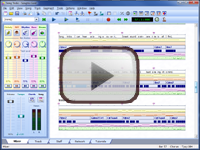(4.4) Harmonic Minor Scale
We are now really starting to look at other types of scales. As mentioned earlier, everything up to this point has been very much based on the Major scale.
Even the Natural Minor scale is basically equivalent to the Major scale. Because it contains the same pattern of intervals, but starting on a different note, it is known as a mode (the Aeolian mode, to be precise) of the Major scale. More on this later.
By contrast, the Harmonic Minor scale contains a distinctly different pattern of intervals.

At first glance, it looks quite similar to the Natural Minor scale, except with the last note raised by a semitone (making a natural seventh degree instead of a flat seventh).
However, this one change makes a big difference to melodies and harmonies formed from the notes of the scale. Here again is the chord sequence in A Natural Minor from the previous topic.

Now compare it to the equivalent sequence in A Harmonic Minor. Because the note G is replaced with G♯, this includes an Emaj chord instead of Em. Notice how this causes the harmony to resolve much more firmly to the final Am.

The Harmonic Minor scale has an interval of three semitones (another minor third) between the sixth and seventh note, which produces stronger harmonies in its related chords. This is the reason for its name.
It also produces very distinctive melodies. One of best known examples is Toccata by JS Bach.

As written here, this piece uses the closest key signature of Am (or C Major) with no sharps or flats, but the G notes are sharpened with accidentals.
We have to do this, because the standard key signatures are all designed for the Major scale. The Harmonic Minor contains a distinctly different set of intervals which do not exactly match with any Major scale.
Wherever you see the consistent use of accidentals for particular notes like this, it is a strong clue that the piece of music uses a scale type other than the Major scale.

ChordWizard products are designed to operate with other scale types just as easily as they do with the Major scale.
They maintain a collection of standard scale types which you can activate or deactivate according to your playing level.
|
Topic 50 of 117
| ||
Bring these music concepts to life with the free Songtrix Bronze Edition as you create songs from chords and scales.
Then publish and share your ideas with the other musicians you meet on the ChordWizard Network.
Have questions? Join the ChordWizard Network and post them in the Music Theory forum for answers and discussions on your topics of interest.








